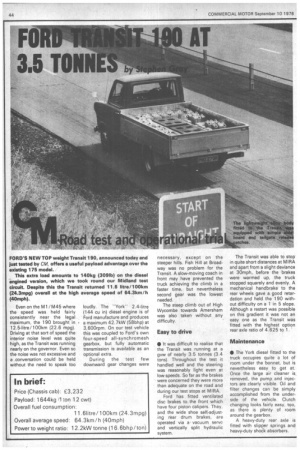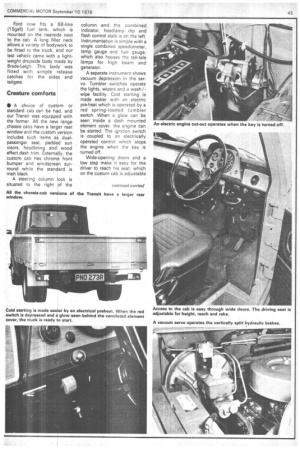FORDS NEW TOP weight Transit 190, announced today and just
Page 46

Page 47

If you've noticed an error in this article please click here to report it so we can fix it.
tested by CM, offers a useful payload advantage over the existing 175 model.
This extra load amounts to 140kg (3091b) on the diesel engined version, which we took round our Midland test circuit. Despite this the Transit returned 11.6 litre/100km (24.3mpg) overall at the high average speed of 64.3km/h (40mph).
Even on the M1 /M45 where the speed was held fairly consistently near the legal maximum, the 190 brought in 12.5-litre/100km (22.6 mpg). Driving at that sort of speed the interior noise level was quite high, as the Transit was running nearly on the governor. Even so the noise was not excessive and a conversation could be held without the need to speak too
loudly. The -York" 2.4-litre (144 cu in) diesel engine is of Ford manufacture and produces a maximum 42.7kW (58bhp) at 3,600rpm. On our test vehicle this was coupled to Ford's own four-speed all-synchromesh gearbox, but fully automatic transmission is available as an optional extra.
During the test few downward gear changes were necessary, except on the steeper hills. Fish Hill at Broadway was no problem for the Transit. A slow-moving coach in front may have prevented the truck achieving the climb in a faster time, but nevertheless second gear was the lowest needed.
The steep climb out of High Wycombe towards Amersham was also taken without any difficulty. •
Easy to drive
• It was difficult to realise that the Transit was running at a gvw of nearly 3.5 tonnes (3.4 tons). Throughout the test it handled well and the steering was reasonably light even at low speeds. So far as the brakes were concerned they were more than adequate on the road and during our test stops at MIRA.
Ford has fitted ventilated disc brakes to the front which have four piston calipers. They, and the wide shoe self-adjusting rear drum brakes, are operated via a • vacuum serve and vertically split hydraulic system.
The Transit was able to stop' in quite short distances at I'VlIRA and apart from a slight deviance at 30mph, before the brakes were warmed up, the truck stopped squarely and evenly. A mechanical handbrake to the rear wheels gave a good retardation and held the 190 without difficulty on a 1 in 5 slope. Although a restart was possible on this gradient it was not an easy one as the Transit was fitted with the highest option rear axle ratio of 4.625 to 1. • Maintenance
• The York diesel fitted to the truck occupies quite a lot of room under the bonnet, but is nevertheless easy to get at. Once the large air cleaner is, removed, the pump and injectors are clearly visible. Oil and filter changes can be simply accomplished from the underside of the vehicle. Clutch changing looks fairly easy, too, as there is plenty of room around the gearbox.
A heavy-duty rear axle is fitted with slipper springs and heavy-duty shock absorbers. Ford now fits a 68-litre (15gall) fuel tank, which is mounted on the nearside next to the cab A long filler neck allows a variety of bodywork to be fitted to the truck, and our test vehicle came with a lightweight dropside body made by Brade-Leigh. This body was fitted with simple release catches for the sid s and tailgate.
Creature comforts
• A choice of cust m or standard cab can be h d, and our Transit was equip.p d with the former. All the ne range ,chassis cabs have a lar er rear. window and the custom ersion includes such items a dualpassenger seat, padd d sun visors, headlining and wood effect dash trim. Extern Ily, the custom cab has chrom front bumper and windscre n surround while the stan ard is matt black.
A steering column ock is situated to the right of the column and the combined, indicator, headlamp dip and flash control stalk is on the left. Instrumentation is simple with a single combined speedometer, temp gauge and fuel gauge, which also houses the tell-tale lamps for high beam and . generator.
A separate instrument shows vacuum depression in the servo. Tumbler switches operate the lights, wipers and a wash /wipe facility. Cold starting is made easier with an electric pre-heat which is operated by a red spring-loaded tumbler. switch. When a glow can be seen inside a dash mounted element cover, the engine can be started. The ignition switch is coupled to an electrically operated control which stops the engine when the key is turned off.
Wide-opening doors and a low step make it easy for the driver to reach his seat, which on the custom cab is adjustable




























































































